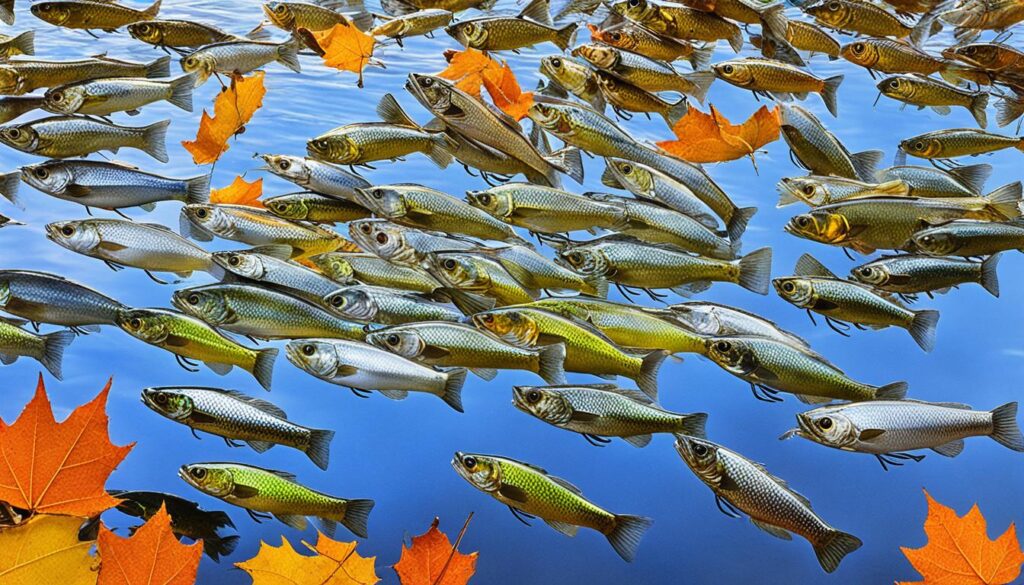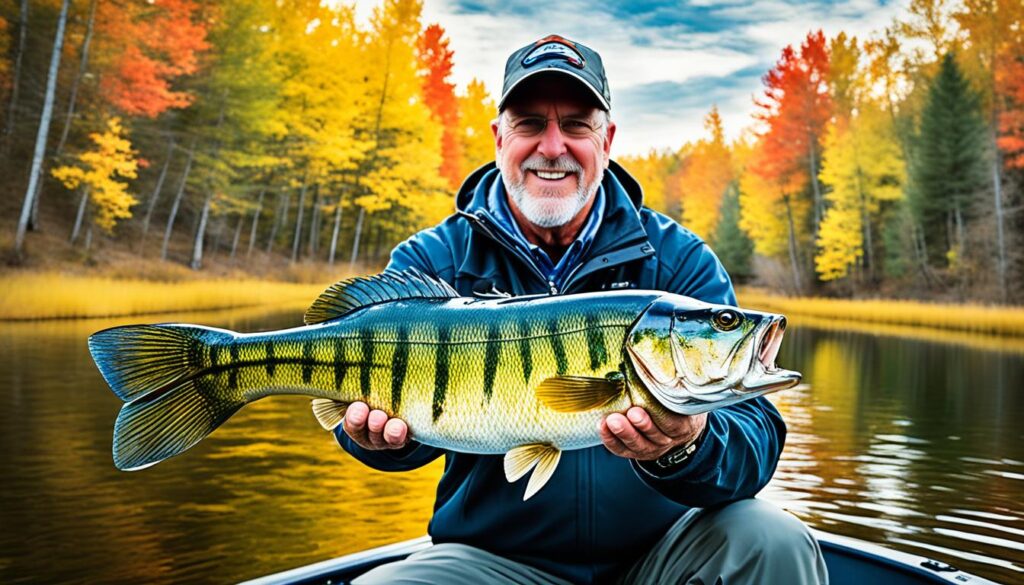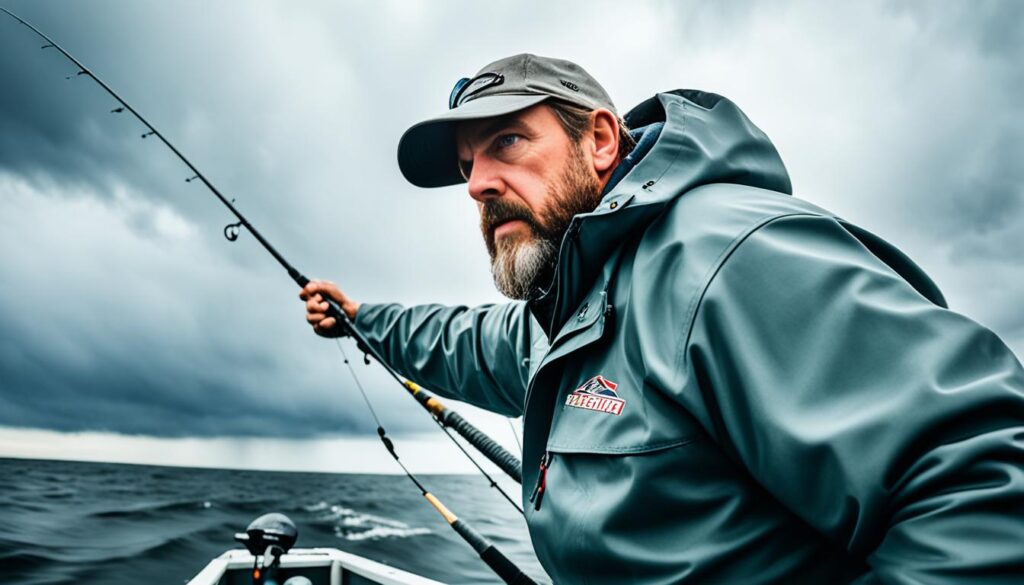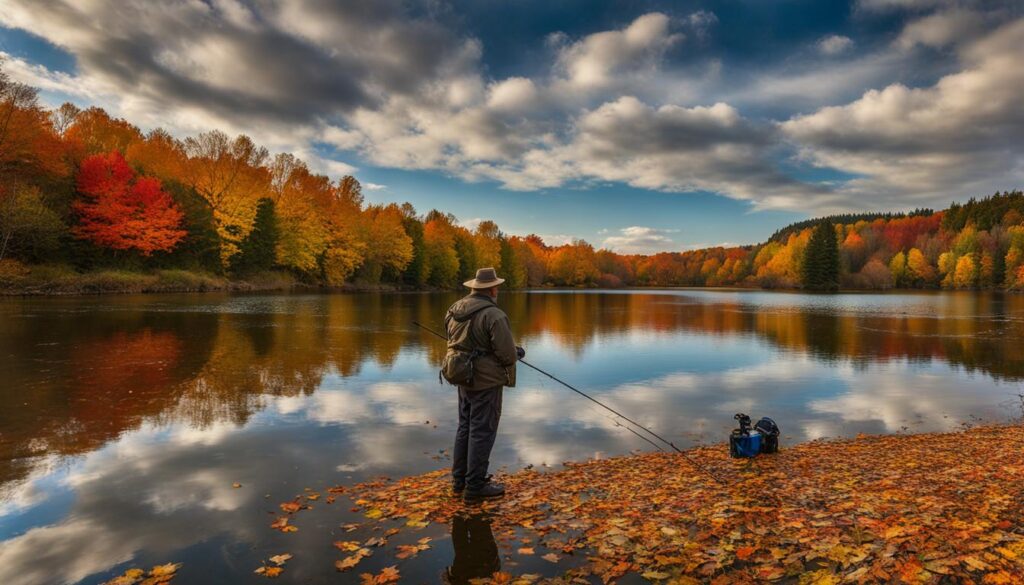In this article, I will share effective strategies for finding deep fall bass quickly. Whether you’re a beginner or an experienced angler, these tips and techniques will help you boost your catch rate during autumn fishing. I have gathered information from various sources to provide you with the most valuable insights and practical advice.
Key Takeaways:
- Utilize deep water bass techniques to locate bass in the fall.
- Use fast bass location hacks to find bass quickly.
- Implement autumn bass fishing tricks to increase your catch rate.
- Focus on strategies for catching bass fast during the fall season.
- Explore deep water bass fishing in the fall for productive fishing spots.
Finding Offshore Bass in the Fall
To effectively locate offshore bass during the fall season, it’s important to adjust your approach and focus on specific areas. Professional angler Brandon Lester offers valuable insights on finding bass in offshore locations during this time. Instead of targeting main river ledges, concentrate your efforts on defined creek channels near the mouths of major pockets.
When searching for bass, pay close attention to structured areas that can act as stopping points for bass as they make their way towards the backs of creeks. Look for features such as roadbeds, humps, creek channel ledges, or points. Bass tend to congregate in these high percentage areas, providing you with better chances of success.
Remember, you’re not looking for large schools of bass. In the fall, bass tend to gather in smaller groups or even as individual fish. Keep an eye out for these smaller targets and adapt your strategy accordingly.
Additionally, it’s crucial to adjust your depth range for fall bass fishing. During this time of year, bass typically stay shallower. Aim for a depth range of 8-14 feet of water to increase your chances of locating and catching bass.
By focusing on offshore bass fishing, understanding fall bass migration patterns, searching for bass near creek mouths, identifying high percentage areas, and adjusting your depth range, you’ll be well-equipped to find success during fall bass fishing season.
The Importance of Baitfish in Fall Bass Fishing
In fall bass fishing, baitfish play a vital role in attracting and triggering bass strikes, both in shallow and deep water. Paying attention to the presence of baitfish can greatly enhance your fishing success during this season. Here are some key factors to consider when it comes to baitfish in fall bass fishing:
Identifying Baitfish Presence in Fall
One of the most effective ways to locate baitfish is by using your electronics. While scanning the waters, keep an eye out for large concentrations of baitfish. Even if you don’t spot individual bass on your screen, seeing a significant number of shad or other baitfish near a structure is a promising indication of potential bass activity. Remember, where there’s bait, there’s likely bass nearby.
Selecting Bait Based on Baitfish Activity
Once you’ve located areas with abundant baitfish, it’s essential to select bait that mimics the forage species present. Bass are more likely to strike lures that closely resemble the baitfish they are actively feeding on. Pay attention to the size, shape, and color of the baitfish in the area, and choose lures that match those characteristics. This can increase your chances of enticing a bite and effectively targeting feeding bass.
Feeding Windows in Fall Fishing
In fall, bass often exhibit distinct feeding windows, which are periods of heightened feeding activity. These windows typically occur during the early mornings and evenings when bass are more active. Take advantage of these optimal feeding times by planning your fishing trips accordingly. By being on the water during feeding windows, you’ll increase your chances of encountering aggressive and actively feeding bass.
“Knowing the feeding patterns and behavior of both baitfish and bass is crucial for success in fall fishing. Paying attention to where baitfish are present, selecting the right bait, and timing your fishing trips can make a significant difference in your catch rate.”
If you find that the bass are being finicky and not actively chasing lures, consider switching to more finesse techniques or using larger, louder topwater lures to grab their attention and trigger a strike. Experimenting with different lures and techniques can help you dial in on what the bass are most responsive to during each specific feeding window.

Effective Baits for Fall Bass Fishing
When it comes to fall bass fishing baits, simplicity is key. As the water temperatures begin to cool, bass become more selective in their feeding habits. To increase your chances of success, consider using a combination of mid-depth crankbaits, silent plugs, topwater lures, and a ned rig with a meatier soft plastic.
Mid-Depth Crankbaits
Mid-depth crankbaits are versatile lures that can effectively target both shallow and deep bass. The Strike King 5XD and Rapala DT-14 are popular choices among anglers. These lures mimic the movements of baitfish, enticing bass to strike. Experiment with different colors to determine the most effective for your local conditions.
Silent Plugs
When bass are feeling finicky, opting for silent plugs can make a significant difference. Silent plugs lack the rattling noise produced by aggressive crankbaits. The absence of noise can fool wary bass into biting. Remember to vary your retrieval speed and pause occasionally to imitate injured prey.
Topwater Lures for Fall Bass
Surface feeding activity is common during the fall, especially early in the mornings and evenings. Having a big, loud topwater lure like the Evergreen Shower Blows in your tackle box can help you capitalize on these feeding windows. Choose colors that resemble local baitfish species and work the lure with short, erratic twitches to imitate an injured or fleeing baitfish.
Ned Rig with Meatier Soft Plastic
For finesse fishing and enticing finicky bass, consider using a ned rig with a meatier soft plastic. The Z-Man Big TRD is a popular choice among anglers. The ned rig’s compact profile combined with a slow, subtle presentation can trigger strikes from bass that may be less active during the fall months. Experiment with different retrieve speeds and colors to find what works best for your local waters.
By incorporating these effective fall bass fishing baits into your tackle box, you’ll be well-prepared to tempt bass during the autumn season. Remember to adjust your techniques based on the prevailing conditions and adapt to the changing behavior of the bass. Good luck and happy fishing!
Simplifying Tackle Selection for Fall Bass Fishing
When it comes to fall bass fishing, simplicity is key. Instead of overwhelming yourself with a variety of tackle options, focus on a few essential baits that are proven to be effective during this season. By using a targeted selection, you can maximize your chances of landing those elusive fall bass.
Essential Baits for Fall Bass Fishing
For fall bass fishing, there are five must-have baits that every angler should consider:
- Crankbaits
- Jerkbaits
- Swimbaits
- Topwaters
- Lipless Crankbaits
Each of these baits serves a specific purpose and can help you cover different water conditions and depths.
Tackle Selection Tips
Here are some tackle selection tips for each of these essential fall bass baits:
| Bait | Tackle Selection Tips |
|---|---|
| Crankbaits | Choose shallow and mid-depth variations based on water clarity. Target areas with shallow flats close to creek channels. |
| Jerkbaits | Opt for simple colors and use jerkbaits to trigger a reaction bite from schooling bass. Vary your retrieval speed and cadence for best results. |
| Swimbaits | Bring out big swimbaits when you locate schools of fish. Target larger bass with these realistic presentations. Experiment with different sizes and colors to find what works best for your local conditions. |
| Topwaters | Experiment with a variety of topwater lures, including buzzbaits, poppers, and walking baits. Consider upsizing your hooks for better hookups, especially when targeting larger fall bass. |
| Lipless Crankbaits | Lipless crankbaits are excellent search baits. Use them to cover a lot of water quickly and locate active bass. Vary your retrieval speed to find the most effective presentation. |
Remember, the key is to simplify your tackle selection for fall bass fishing. By focusing on these essential baits and understanding how to use them effectively, you can increase your chances of hooking into some impressive autumn bass.
Timing and Water Temperature Considerations
The timing of fall bass fishing can vary depending on location and conditions. While there is no specific time or temperature for the transition to fall patterns, several factors should be considered when planning your fishing trips. One crucial aspect to consider is the presence of baitfish, as bass will follow their migration patterns during the fall. Additionally, keep an eye on changes in weather, as a drop in temperature or the occurrence of cold fronts can trigger bass to move to shallower areas.
An essential factor to monitor is water temperature. When the water temperature dips around 50 degrees, it often signals larger bass to move shallower, seeking out warmer areas. This is the time when targeting areas with active baitfish becomes crucial, as bass will feed more aggressively. As the transition to fall patterns occurs, fishing strategies should be adjusted accordingly to adapt to the changing behaviors and preferences of bass.
The Impact of Water Temperature on Fall Bass Fishing
“Water temperature plays a significant role in the movements and feeding patterns of bass during the fall season. Understanding these temperature changes can help anglers plan their fishing trips for optimal success.” – Professional Angler
By paying close attention to water temperature, you can gauge the activity level of bass and choose the most effective fishing strategies. Different water temperature ranges indicate distinct patterns and behaviors:
- Warm Water (Above 65°F): During the early fall, when water temperatures are still relatively warm, bass tend to be more active and can be found in various areas of the lake. They are more likely to chase fast-moving baits and explore different depths. Focus on shallow structures, such as weed beds and points near creek channels, where bass may seek cover and ambush prey.
- Cool Water (55-65°F): As the fall progresses and water temperatures begin to cool, bass become more predictable. They start shifting towards deeper areas, but still stay within close proximity to feeding grounds. Target points, drop-offs, and submerged structures near creek channels or areas with abundant baitfish. Crankbaits and swimbaits can be effective lures to locate and entice bass during this transitional phase.
- Cold Water (Below 55°F): In late fall, when water temperatures drop significantly, bass become more sluggish and less active. They tend to concentrate in deeper areas with stable temperatures, such as main lake points, ledges, and submerged structures. Slow presentations like jigs, jerkbaits, and Carolina rigs can be effective in enticing lethargic bass to strike.
Understanding how water temperature affects bass behavior and adapting your fishing strategies accordingly can greatly enhance your chances of success during fall bass fishing.

Adapting to Changing Conditions
When it comes to fall bass fishing, adapting to changing conditions is essential for success. Each lake has its unique characteristics and can vary greatly during the fall season. As an angler, it’s crucial to understand how these conditions can impact your fishing strategies and adjust accordingly.
One important factor to consider is water clarity. Some lakes may have crystal clear water, while others may be murky or stained. Adapting your bait selection and presentation based on water clarity can make a significant difference in attracting bass. In clear water, opt for more natural-looking lures with subtle movements, while in murky water, use lures with brighter colors and more aggressive action.
Weed growth is another condition that varies from lake to lake. Some lakes may have extensive weed beds, providing excellent cover for bass, while others may have minimal weed growth. Bass tend to seek refuge and feed around weed beds, so understanding the level of weed growth in the lake you’re fishing will help you determine the most effective fishing techniques.
The weather also plays a significant role in fall bass fishing. Changes in temperature, wind patterns, and barometric pressure can affect the behavior of bass. In colder weather, bass may become more sluggish, and you may need to slow down your retrieve. On windy days, bass may be more active and feeding near the surface. Paying attention to weather conditions can guide you in selecting the right lure, presentation, and fishing locations.
One strategy for adapting to changing conditions is to explore different lakes. By trying new lakes, you expose yourself to various conditions and challenges, making you a more versatile angler. Each lake will present its own set of obstacles and opportunities, allowing you to expand your knowledge and skills.
Fishing pressure is also an important consideration. Popular lakes attract more anglers, resulting in increased fishing pressure. If a lake is crowded, consider exploring less crowded areas that receive less fishing pressure. These areas may have calmer and less wary bass, increasing your chances of success.
Finding Deep Fall Bass in Changing Conditions
When facing changing conditions, it’s essential to adjust your fishing strategies. If you’re fishing a lake with clear water and extensive weed growth, targeting areas near the edges of weed beds can yield excellent results. Bass often use weed edges as ambush points and feeding grounds. Use lures that can navigate through the vegetation, such as weedless jigs, Texas rigs, or topwater frogs.
On the other hand, if you’re fishing a lake with murky water and minimal weed growth, focus on areas with structure or cover, such as submerged trees, rocks, or drop-offs. These areas provide hiding spots for bass and allow them to ambush prey. Crankbaits, spinnerbaits, and jigs with vibrant colors and strong vibrations can be effective in attracting bass in these conditions.
Regardless of the conditions, it’s always a good idea to experiment with different techniques. Try different baits, retrieve speeds, and depths until you find what works best. By adapting to changing conditions and exploring new lakes, you’ll become a more versatile angler and increase your chances of finding and catching deep fall bass quickly.

| Conditions | Strategy |
|---|---|
| Clear Water | Use natural-looking lures with subtle movements |
| Murky Water | Opt for lures with brighter colors and more aggressive action |
| Extensive Weed Growth | Target areas near weed beds with weedless jigs, Texas rigs, or topwater frogs |
| Minimal Weed Growth | Focus on areas with structure or cover using crankbaits, spinnerbaits, or jigs |
| Increased Fishing Pressure | Explore less crowded areas with calmer and less wary bass |
Personal Experiences and Observations
Fall bass fishing is a dynamic and exciting activity that offers unique experiences for anglers. Through my personal fall bass fishing experiences, I have discovered successful techniques and observed interesting fish behaviors. Here are some valuable insights based on my observations:
Areas to Target
When it comes to finding fall bass, targeting shallow flats with slop and weed cover can yield excellent results. These areas provide bass with ample cover and easy access to food sources, making them prime locations to explore.
Successful Techniques
While different anglers may have their preferred techniques, I have found success using specific lures in my fall bass fishing endeavors. Whopper Ploppers, swim jigs, and spinnerbaits have proven effective in enticing strikes from bass during this season. Experiment with these lures to see which ones work best for you.
Observations on Fish Behavior
One interesting observation I have made is that smaller fish tend to show up in shallower areas before larger fish transition. Keep this in mind when deciding where to focus your efforts. Additionally, pay attention to the behavior of baitfish in your area, as bass will often follow their movements.
By adapting your techniques to your local conditions and making observations based on your own experiences, you can enhance your fall bass fishing outings. Remember to stay flexible and open to trying new approaches to optimize your chances of success on the water.
Conclusion
As we conclude our exploration of fall bass fishing, it’s clear that this season offers ample opportunities for anglers to target and catch deep bass. By implementing the various tips and techniques shared in this article, you can significantly increase your success rate in finding fall bass quickly.
One essential aspect to keep in mind when targeting fall bass is to focus on areas near creek mouths. These locations often serve as prime spots for bass during this season, providing them with easy access to baitfish and offering promising opportunities for anglers.
Another key factor to consider is baitfish activity. Paying close attention to the presence and behavior of baitfish can help you identify the areas where bass are likely to be feeding. Utilize your electronics to locate these baitfish-rich areas, which can greatly enhance your chances of success.
To simplify your tackle selection, focus on a few essential baits for fall bass fishing, including mid-depth crankbaits, jerkbaits, swimbaits, topwaters, and lipless crankbaits. These versatile and effective lures can help you cover various depths and tempt bass into striking.
Lastly, remember to adapt your fishing strategies to the changing conditions you encounter on the water. Each lake may present different challenges and opportunities during the fall season, so it’s crucial to remain observant and willing to experiment with different techniques. With a bit of flexibility and a lot of passion, fall bass fishing can be a thrilling and rewarding pursuit. Tight lines and happy fishing!
FAQ
How can I find deep fall bass quickly?
To find deep fall bass quickly, focus on defined creek channels near the mouths of major pockets. Look for structured areas like roadbeds, humps, creek channel ledges, or points where bass may stop on their way towards the backs of creeks. Adjust your depth range to 8-14 feet of water and target smaller groups or individual fish instead of large schools.
Why are baitfish important in fall bass fishing?
Baitfish play a crucial role in fall bass fishing. Look for areas with abundant baitfish, which can be identified using your electronics. The presence of lots of baitfish near a structure is a good sign, even if you don’t see individual bass on your screen. Pay attention to feeding windows, especially in the early mornings and evenings.
What are some effective baits for fall bass fishing?
For fall bass fishing, mid-depth crankbaits like the Strike King 5XD or Rapala DT-14 are great choices. Opt for silent plugs over aggressive, rattling crankbaits. Keep a big, loud topwater lure like the Evergreen Shower Blows on hand for surface feeding activity. Consider using a ned rig with a meatier soft plastic like the Z-Man Big TRD for finesse fishing.
How do I simplify tackle selection for fall bass fishing?
Instead of overloading your tackle box, focus on a few key presentations for fall bass fishing. Choose crankbaits, jerkbaits, swimbaits, topwaters, and lipless crankbaits. Select shallow and mid-depth variations of crankbaits based on the water clarity and target areas with shallow flats close to creek channels. Experiment with different techniques and lure colors.
When is the best time for fall bass fishing?
The timing of fall bass fishing can vary, but key factors to consider are the presence of baitfish, changes in weather, and the onset of the thermocline. Pay attention to water temperatures around 50 degrees, as this often triggers larger bass to move shallower. Target areas with active baitfish and focus on high percentage spots.
How do I adapt to changing conditions in fall bass fishing?
Each lake can have different conditions during the fall, so adapt your strategies accordingly. Pay attention to water clarity, weed growth, and changes in weather patterns. Some lakes may experience extended heat, spraying, or reduced weed growth, which can impact the behavior and location of bass. Explore new lakes and less crowded areas for better results.
What are some personal experiences and observations in fall bass fishing?
Fall bass fishing experiences can vary, but some anglers have reported success by targeting shallow flats with slop and weed cover. Others have found success with specific lures like whopper ploppers, swim jigs, and spinnerbaits. Smaller fish tend to show up in shallower areas before larger fish transition. Pay attention to local conditions and adapt techniques based on personal experiences and observations.
Can you provide a summary of tips and techniques for finding deep fall bass quickly?
To find deep fall bass quickly, focus on defined creek channels near the mouths of major pockets. Look for structured areas and adjust your depth range to 8-14 feet of water. Pay attention to the presence of baitfish, utilize effective baits like crankbaits and topwaters, simplify your tackle selection, and adapt to changing conditions. Experiment with different techniques and enjoy the thrill of fall bass fishing.
